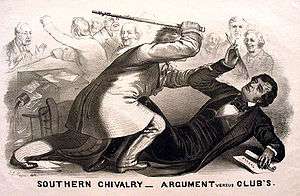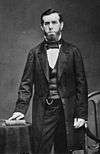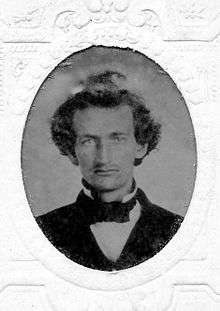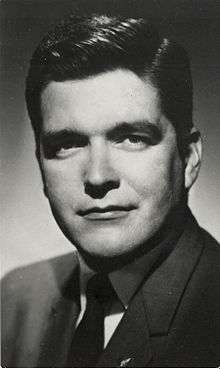List of United States Congress members killed or wounded in office

Since the United States Congress was established with the 1st Congress in 1789, fourteen of its members have been killed while in office by people seeking to do them harm, and nine members have suffered serious injuries as a result of such attacks. The members of Congress included in this list were either injured or killed by someone intending to do them serious harm, or there is a serious claim that there was a lethal intent from an unknown assailant (such as the two congressmen who died of National Hotel Disease). The earliest a member of Congress was killed or wounded while in office was 1831 when Spencer Pettis was killed in a duel and the most recent death occurred in 1983 when a plane carrying Larry McDonald was shot down over the Pacific Ocean. The most recent Congress member to be wounded was Gabrielle Giffords who was seriously injured during the 2011 Tucson shooting.
Out of the 14 Congress members killed in office, all of them were male and 10 were Democrats while four were Republicans. Three members died in duels, and a total of nine (six members of the House of Representatives and three senators) died from gunshot wounds.
Nine Congress members have been wounded while in office. Three of the wounded were Republicans, five were Democrats, and one was a member of the Free Soil Party. Only one was a woman, and only three were senators. Five of those injured were wounded during the 1954 United States Capitol shooting incident.
Lists
Killed
Party colors: Democratic Republican
| Member | State (district) |
Date of incident | Perpetrator(s) | Incident | ||
|---|---|---|---|---|---|---|
| Spencer Pettis | – | Missouri (1st at-large seat) |
August 28, 1831 | Thomas Biddle | Both Pettis and Biddle sustained fatal gunshot wounds during a duel on Bloody Island in Illinois.[1] | |
| Jonathan Cilley |  |
Maine (3rd district) |
February 24, 1838 | William Graves | Cilley was shot by Graves, the Whig Congressman from Kentucky's 8th district, during a duel on the Marlboro Pike in Maryland.[1] | |
| John Montgomery | – | Pennsylvania (12th district) |
April 24, 1857 | Unknown (disputed) | Several people staying at the National Hotel in Washington, D.C., died of National Hotel Disease during this time period. It is disputed whether the "disease" was due to deliberate poisoning or accidental food poisoning.[1] | |
| John Quitman |  |
Mississippi (5th district) |
July 17, 1858 | |||
| David Broderick |  |
California (senator) |
September 13, 1859 | David Terry | Broderick and Terry, the Chief Justice of the Supreme Court of California, took part in a duel in San Francisco. Broderick was shot and died three days later.[1] | |
| Edward Baker |  |
Oregon (senator) |
October 21, 1861 | 7th Brigade, 4th Division of the Confederate Army of the Potomac (under the command of Nathan Evans) | Baker died during the Battle of Ball's Bluff, while assigned command of a brigade in Brigadier General Charles Pomeroy Stone's division, guarding fords along the Potomac River in Virginia. The Confederate soldiers were commanded by Brigadier General Nathan George Evans.[2][3] | |
| Cornelius Hamilton | .jpg) |
Ohio (8th district) |
December 22, 1867 | Thomas Hamilton | Hamilton was killed by his insane 18-year-old son, Thomas, in Marysville, Ohio.[1][4] | |
| James Hinds |  |
Arkansas (2nd district) |
October 22, 1868 | George Clark | Hinds was killed in Indian Bays in Monroe County, Arkansas, after being shot in the back by George A. Clark, a member of the Ku Klux Klan and the secretary of the Democratic committee of the county.[1][5][6] | |
| Thomas Haughey |  |
Alabama (6th district) |
July 31, 1869 | Collins (first name not known) | At a speech by Haughey in Courtland, Alabama, he and Collins got into an argument. This escalated into a fist fight and ended with Collins shooting Haughey in the stomach. Haughey died five days later.[7] | |
| John Pinckney |  |
Texas (8th district) |
April 24, 1905 | Unknown (riot started by J. N. Brown) | A political event in Hempstead, Texas, turned violent when one of the participants, J. N. Brown, began shooting. Other attendees began to shoot as well and a riot broke out. Pinckney, his brother Tom, and Brown were all killed at the scene.[1][8] | |
| Huey Long |  |
Louisiana (senator) |
September 8, 1935 | Carl Weiss (disputed) | Long died two days after Weiss fired a handgun at him at close range inside the Louisiana State Capitol in Baton Rouge. More recent evidence suggests that Long's bodyguards may have accidentally shot and killed Long when they opened fire on Weiss, who was killed at the scene.[9][10] | |
| Robert Kennedy |  |
New York (senator) |
June 5, 1968 | Sirhan Sirhan | Kennedy was shot at the Ambassador Hotel in Los Angeles after giving a speech for his presidential campaign; he died about 25 hours later.[11] | |
| Leo Ryan |  |
California (11th district) |
November 18, 1978 | Peoples Temple (under the direction of Jim Jones) | While on an official visit to Guyana to investigate the activities of the Peoples Temple group led by Jim Jones, Ryan was shot multiple times while boarding an airplane leaving Jonestown.[12] | |
| Larry McDonald |  |
Georgia (7th district) |
September 1, 1983 | Soviet Far East District Air Defense Forces (under orders from Anatoly Kornukov) | McDonald was a passenger on board Korean Air Lines Flight 007 which was shot down over the Sea of Japan near Sakhalin island by Soviet interceptors on the orders of General Kornukov, Commander of Sokol Air Base.[13] | |
Wounded
Party colors: Democratic Free Soil Republican
| Member | State (district) |
Date of incident | Perpetrator(s) | Incident | ||
|---|---|---|---|---|---|---|
| Charles Sumner |  |
Massachusetts (senator) |
May 22, 1856 | Preston Brooks | Representative Preston Brooks, a Democrat from South Carolina's 4th district, assaulted Sumner with a cane on the floor of the Senate in the Capitol Building in Washington, D.C. The attack followed Sumner's verbal attacks on pro-slavery politicians.[14] | |
| Josiah Grinnell |  |
Iowa (4th district) |
June 14, 1866 | Lovell Rousseau | Grinnell was assaulted with an iron-tipped cane by Rousseau, an Unconditional Unionist Congressman from Kentucky's 7th district, on the east portico of the Capitol Building in Washington, D.C., in retaliation for derogatory statements he made earlier. Grinnell was pummeled on the "head and face until the cane broke," and was heavily bruised.[15] | |
| Alvin Bentley |  |
Michigan (8th district) |
March 1, 1954 | Rafael Cancel Miranda, Andres Figueroa Cordero, Irving Flores Rodríguez, Lolita Lebrón |
Armed Puerto Rican nationalists shot the representatives from the Ladies Gallery of the House of Representatives in the Capitol Building in Washington, D.C.[16] | |
| Clifford Davis |  |
Tennessee (10th district) | ||||
| George Fallon |  |
Maryland (4th district) | ||||
| Ben Jensen |  |
Iowa (7th district) | ||||
| Kenneth Roberts |  |
Alabama (4th district) | ||||
| John Stennis |  |
Mississippi (senator) |
January 29, 1973 | Unknown (two young men) | Stennis was shot twice outside his home in Washington, D.C. during a mugging.[17] | |
| Gabrielle Giffords |  |
Arizona (8th district) |
January 8, 2011 | Jared Loughner | Giffords was shot in the head during the 2011 Tucson shooting, which occurred at a constituency meeting held in a supermarket parking lot in Casas Adobes, Arizona.[18] | |
See also
- United States Congress members who died in office
- List of assassinated American politicians
- List of United States federal judges killed in office
- List of United States presidential assassination attempts and plots
References
- 1 2 3 4 5 6 7 Amer, Mildred (2002-03-14). "Members of the U.S. Congress Who Have Died of Other Than Natural Causes While in Office" (PDF). Congressional Research Service. Retrieved 2011-01-12.
- ↑ "BAKER, Edward Dickinson, (1811 - 1861)". Biographical Directory of the United States Congress. United States Congress. Retrieved 2011-01-11.
- ↑ "Brig. Gen. Nathan George "Shanks" Evans". Marion County, SC in the War Between the States. Retrieved 2011-01-11.
- ↑ "The Murder of Mr. Hamilton.". The New York Times. 1867-12-26. Retrieved 2011-01-12.
- ↑ Foner, Eric (March 1989). Reconstruction: America's Unfinished Revolution, 1863–1877. New York City: Harper & Row. p. 342. ISBN 978-0-06-093716-4. OCLC 48074168.
- ↑ Stanton, Amanda. "James Hinds (1833–1868)". The Encyclopedia of Arkansas History and Culture. The Central Arkansas Library System. Retrieved 2011-01-11.
- ↑ Nancy Marion; Willard Oliver (22 July 2014). Killing Congress: Assassinations, Attempted Assassinations and Other Violence against Members of Congress. Lexington Books. pp. 17–27. ISBN 978-0-7391-8360-1.
- ↑ "Congressman Pickney Shot in a Texas Riot". The New York Times. 1905-04-25. Retrieved 2011-01-12.
- ↑ "Huey Long's Assassination". Huey Long: The Man, His Mission, and Legacy. Long Legacy Project. Retrieved 2011-01-12.
- ↑ Unsolved Mysteries: Who Shot Huey Long? (Television production). 1993.
- ↑ "KENNEDY, Robert Francis, (1925 - 1968)". Biographical Directory of the United States Congress. United States Congress. Retrieved 2011-01-12.
- ↑ United States House of Representatives; Foreign Affairs Committee (1979-05-15). "Congressional Foreign Affairs Committee report on Ryan's assassination". Report of a Staff Investigative Group to the Committee on Foreign Affairs. United States Congress.
- ↑ Wilkes, Jr., Donald E. (2003-09-03). "The Death Flight of Larry McDonald". Flagpole Magazine. pp. 7, 9. Retrieved 2011-01-16.
- ↑ "SUMNER, Charles, (1811 - 1874)". Biographical Directory of the United States Congress. United States Congress. Retrieved 2011-01-12.
- ↑ "Historical Highlights: Representative Lovell H. Rousseau assaults Representative Josiah B. Grinnell". Office of History and Preservation of the Clerk of the United States House of Representatives. Retrieved 2010-01-12.
- ↑ Barone, Michael & Ujifusa, Grant (1993). The Almanac of American Politics 1994. Washington, D.C.: National Journal Group. p. 749. ISBN 0-89234-057-6. OCLC 32984467.
- ↑ "Senator From Mississippi Reported As Very Serious". Spartanburg Herald-Journal. Associated Press. 1973-02-01. Retrieved 2011-05-09.
- ↑ Halloran, Liz (2011-01-08). "'Vitriol' Cited As Possible Factor In Arizona Tragedy". NPR. Retrieved 2011-01-12.
Further reading
- Nancy Marion; Willard Oliver (22 July 2014). Killing Congress: Assassinations, Attempted Assassinations and Other Violence against Members of Congress. Lexington Books. pp. 14–. ISBN 978-0-7391-8360-1.